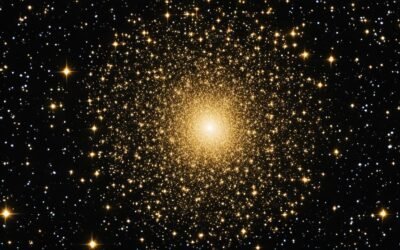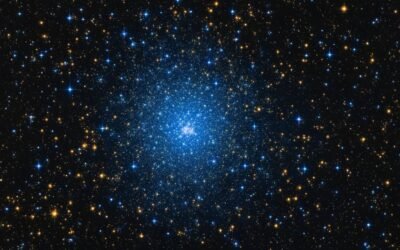Welcome to the captivating world of Messier 69, a stunning globular cluster nestled in the depths of the constellation Sagittarius. Also known as NGC 6637, Messier 69 has been a source of fascination and exploration since its discovery by the renowned astronomer Charles Messier in 1780. With its intriguing characteristics and close proximity to another globular cluster, Messier 70, this celestial wonder offers a wealth of knowledge about the universe we inhabit.
Key Takeaways:
- Messier 69, also known as NGC 6637, is a globular cluster in the constellation Sagittarius.
- It was discovered by Charles Messier in 1780 and is approximately 28,700 light-years away from Earth.
- Messier 69 has an apparent magnitude of 7.6 and is one of the most metal-rich globular clusters known.
- Observing Messier 69 requires binoculars or small telescopes, and it is best visible during the summer months.
- The cluster has an average concentration of stars, a mass of 200,000 solar masses, and a radius of 45 light-years.
Observation and Location of Messier 69
To observe Messier 69, you can start with small binoculars, although it may not be easy to spot from northern locations due to its low position above the southern horizon. When viewed through binoculars, it appears as a fuzzy star, while with small telescopes, you can see its comet-like shape. If you have access to a larger telescope, you may even be able to resolve individual stars within the cluster. Messier 69 is located inside the Teapot asterism in the constellation Sagittarius, approximately 1-2 degrees north of the line connecting the stars Epsilon Sagittarii and Zeta Sagittarii. The best time to observe Messier 69 is during the summer months.
| Observation Information | |
|---|---|
| Recommended Equipment | Small binoculars, small telescopes |
| Visibility | Difficult from northern locations; low position above the southern horizon |
| Appearance | Fuzzy star in binoculars, comet-like shape in small telescopes |
| Location | Inside the Teapot asterism in Sagittarius, 1-2 degrees north of the line connecting Epsilon Sagittarii and Zeta Sagittarii |
| Best Time for Observation | Summer months |
Physical Characteristics of Messier 69
Messier 69 is a fascinating globular cluster with distinctive physical characteristics that set it apart from other celestial objects in the Messier catalog. Let’s delve into the details and explore what makes this deep space object truly remarkable.
Cluster Concentration and Size
Messier 69 exhibits an average concentration of stars, contributing to its unique appearance in the night sky. With a core diameter measuring 0.68 arc minutes, equivalent to approximately 6 light years, this globular cluster showcases a compact and tightly-knit structure. Its half-mass radius spans 0.83 arc minutes, corresponding to a distance of 7.2 light years, and its vast expanse extends to a tidal radius of 72 light years.
Mass and Stellar Population
With a mass of approximately 300,000 solar masses, Messier 69 is home to an impressively rich collection of stars. It hosts an estimated 125,000 stars within its boundaries, offering a captivating glimpse into the diverse stellar population that inhabits this astronomical wonder.
High Metallicity
One of the distinctive features of Messier 69 is its relatively high metallicity compared to other globular clusters. Its stars boast an iron abundance of about 22% when compared to the Sun, signifying the presence of heavy elements within the cluster. This higher concentration of metals adds to the cluster’s allure and provides valuable insights into the evolution of stars within the galactic bulge population.
Age and Cosmic Origins
Messier 69 is estimated to be approximately 13.06 billion years old, making it one of the oldest globular clusters known to astronomers. Its formation and development encompassed a time when the universe was just around 700 million years old, giving us a glimpse into the early stages of galactic evolution. Studying the age of Messier 69 facilitates a deeper understanding of the cosmic processes that shaped our universe.
By unraveling the physical characteristics of Messier 69, astronomers continue to uncover the mysteries hidden within this globular cluster. Its unique composition, size, and age make it a captivating subject for further astronomical investigations, shedding light on the vast complexities of our cosmic surroundings.
Messier 69’s Neighbor, Messier 70
Messier 69 is a close neighbor to another stunning celestial object – Messier 70, which is also a globular cluster. These two clusters reside at similar distances from Earth, with only about 1,800 light-years separating them. Both Messier 69 and Messier 70 are located in the vicinity of the galactic center, adding to their allure and astronomical significance.
While Messier 69 is positioned around 6,200 light-years away from the galactic center, Messier 70 is not far behind. The proximity of these two Messier objects suggests the intriguing possibility of them being physical neighbors, sharing space in the vast cosmic landscape.
| Messier 69 | Messier 70 |
|---|---|
| Distance from Earth | Approximately 28,700 light-years |
| Apparent Magnitude | 7.6 |
| Cluster Diameter | 45 light-years |
| Mass | 200,000 solar masses |
| Distance from Galactic Center | About 6,200 light-years |
Metallicity of Messier 69
Messier 69 is renowned for its exceptional metallicity among globular clusters. Metallicity refers to the abundance of elements heavier than hydrogen and helium in a celestial object. In the case of Messier 69, its stars showcase a significantly higher abundance of these heavy elements compared to other globular clusters of a similar age.
With an iron abundance of approximately 22% compared to the Sun, Messier 69 stands out as a metal-rich globular cluster. This iron abundance is over ten times greater than what is found in other globular clusters. The high metallicity of Messier 69 can be attributed to its proximity to the galactic center and its association with the Milky Way bulge population. It is worth noting that globular clusters located in the galactic bulge tend to exhibit higher metallicity than those found elsewhere in the galaxy.
To better understand the significance of the metallicity of Messier 69, let’s compare it to the metallicity of other globular clusters. The table below presents a comparison of the iron abundances for Messier 69 and two other well-known globular clusters:
| Globular Cluster | Iron Abundance (% of Sun) |
|---|---|
| Messier 69 | 22% |
| Messier 13 (Hercules Cluster) | 1.5% |
| Messier 22 | 0.4% |
As seen in the table, Messier 69 exhibits significantly higher iron abundance compared to Messier 13 and Messier 22. This high metallicity provides astronomers with valuable insights into the formation and evolution of stars in the galactic bulge population, as well as the overall dynamics of the Milky Way galaxy.

Expanding Our Understanding of Heavy Elements
The metallicity of Messier 69 allows us to delve deeper into the mysteries of heavy element formation. Heavy elements, such as iron, play a crucial role in the evolution of galaxies and the creation of new stars. By studying metal-rich globular clusters like Messier 69, astronomers can gather essential data to refine our understanding of stellar nucleosynthesis and the processes that lead to the enrichment of heavy elements in the universe.
“The high metallicity of Messier 69 sheds light on the intricate interplay between galactic dynamics, stellar formation, and the enriching effects of heavy elements.”
Through continued observations and analysis, scientists hope to uncover further insights into the intriguing relationship between metallicity, heavy elements, and the broader cosmic narrative. Messier 69 stands as a testament to the far-reaching implications of a seemingly small characteristic within a metal-rich globular cluster.
Age of Messier 69
Messier 69, a globular cluster located in the constellation Sagittarius, is estimated to be about 13.06 billion years old, making it one of the oldest known globular clusters. Its stars formed when the universe was only about 700 million years old, making Messier 69 a relic from the early stages of cosmic evolution.
Studying the age of Messier 69, along with other globular clusters, is crucial for astronomers to gain insights into the evolution and history of the cosmos. These astronomical observations provide valuable information about the formation and evolution of stars in the galactic bulge population.
Messier 69’s age is a testament to the enduring nature of celestial bodies in our universe, and it serves as a testament to the vast expanse of space and time that astronomers explore through their observations. Furthermore, understanding the age of Messier 69 and similar objects in the astronomy catalog contributes to our knowledge of space exploration and the vastness of the cosmos.
Messier 69: A Glimpse into the Cosmic Past
“The age of Messier 69 provides valuable insights into the early stages of galaxy formation and the history of our universe. By studying objects like Messier 69, astronomers can gain a deeper understanding of the celestial wonders that surround us.”
The Universality of Age
The age of celestial bodies, such as Messier 69, showcases the commonality of the universe’s timeline. Regardless of their distant locations or unique characteristics, all objects within the cosmos adhere to the same laws of nature and age accordingly. The longevity of Messier 69 reminds us of the vast timescales involved in the grand narrative of space exploration and the inherent beauty of astronomical observations.
Discovery and Observations of Messier 69
Messier 69, a globular cluster, was first discovered by Charles Messier on August 31, 1780. Initially, Messier mistook the cluster for a nebula without a star. Over the years, extensive observations of Messier 69 have been conducted using various telescopes, including the renowned Hubble Space Telescope. These observations have provided valuable insights into the cluster’s metallicity, age, and physical characteristics.
Observations of Messier 69 have greatly contributed to our understanding of the composition and dynamics of globular clusters. The Hubble Space Telescope, with its high-resolution images, has played a crucial role in revealing the intricate details of this celestial object. Through these observations, astronomers have been able to unravel the mysteries of Messier 69 and gain a deeper understanding of its place in the cosmos.
Researchers have used data from these observations to determine Messier 69’s metallicity, which refers to its abundance of elements heavier than hydrogen and helium. Additionally, the observations have shed light on the cluster’s age and physical parameters, providing valuable information about the processes of stellar formation and evolution within globular clusters.
By studying Messier 69 and other globular clusters, astronomers have expanded our knowledge of the universe and deepened our understanding of celestial objects. These observations play a vital role in filling the pages of the Messier catalog and the broader field of astronomy.
If we take a closer look at the properties of Messier 69, we can understand the significance of the observations conducted. Below is a table summarizing some key characteristics of Messier 69:
| Characteristic | Value |
|---|---|
| Discovery Year | 1780 |
| Distance from Earth | Approximately 28,700 light-years |
| Apparent Magnitude | 7.6 |
| Mass | 200,000 solar masses |
| Radius | 45 light-years |
Note: The data in the table is for informational purposes only and is subject to further research and revision as new observations are made.
The observations of Messier 69 have opened new doors in our exploration of the cosmos. They have allowed us to unravel the mysteries of globular clusters and delve deeper into the vastness of the universe. As we continue to study and observe celestial objects like Messier 69, we inch closer to unlocking the secrets of our existence and the wonders that lie beyond.

Variability of Messier 69
Messier 69, despite being a fascinating globular cluster, does not exhibit a high degree of variability. Currently, researchers have identified eight variable stars within the cluster, including two Mira-type stars with periods of approximately 200 days. These variable stars offer valuable insight into the properties and evolution of globular clusters.
Studying variable stars within Messier 69 and their fluctuations in brightness can provide astronomers with crucial data about the cluster’s composition and dynamics. By meticulously observing these celestial objects, scientists can uncover clues about the unique characteristics and behaviors of globular clusters.
“Variable stars often serve as cosmic beacons, guiding our understanding of the intricate workings of the universe.”
Further astronomical observations and intensive studies are required to gain a more comprehensive understanding of the variability of Messier 69. By expanding our knowledge of the cluster’s fluctuating stars, we can deepen our understanding of the processes that shape globular clusters and the larger cosmos.
The variability of Messier 69 is an exciting realm of exploration within the astronomy catalog. As scientists continue to probe the depths of the cosmos, these variable stars offer a tantalizing glimpse into the extraordinary nature of celestial objects.
Significance of Messier 69
Messier 69, located in the constellation Sagittarius, holds immense significance in the field of astronomy. This deep space object, included in the revered Messier catalog, offers valuable insights into the formation and evolution of stars in our Milky Way galaxy.
What makes Messier 69 particularly noteworthy is its metal-rich nature and close proximity to the galactic center. These features, coupled with its association with the galactic bulge population, provide astronomers with a unique opportunity to study the celestial wonders of our universe.
Astronomical observations of Messier 69, alongside other globular clusters, shed light on the early stages of galaxy formation and help unravel the intricate history of our cosmos. By delving deeper into the mysteries of celestial objects like Messier 69, we expand our understanding of the vastness and complexity of space exploration.
FAQ
What is Messier 69?
Messier 69, also known as NGC 6637, is a globular cluster located in the constellation Sagittarius. It was discovered by Charles Messier on August 31, 1780.
How far is Messier 69 from Earth?
Messier 69 is approximately 28,700 light-years away from Earth.
How can I observe Messier 69?
Messier 69 can be observed with small binoculars. In binoculars, it appears as a fuzzy star, while small telescopes can show its comet-like shape. Larger telescopes can resolve individual stars in the cluster.
Where is Messier 69 located?
Messier 69 is located inside the Teapot asterism in Sagittarius, about 1-2 degrees north of the line connecting the stars Epsilon Sagittarii and Zeta Sagittarii.
What are the physical characteristics of Messier 69?
Messier 69 has an average concentration of stars, a core diameter of 0.68 arc minutes (equivalent to about 6 light years), and a half-mass radius of 0.83 arc minutes (or 7.2 light years). Its tidal radius is 72 light years. Messier 69 has a mass of about 300,000 solar masses and contains approximately 125,000 stars.
Is Messier 69 metal-rich?
Yes, Messier 69 is known for being one of the most metal-rich globular clusters. Its stars have a high abundance of elements heavier than hydrogen and helium compared to other globular clusters. Its iron abundance is about 22% compared to the Sun.
How old is Messier 69?
Messier 69 is estimated to be about 13.06 billion years old, making it one of the oldest globular clusters known.
Who discovered Messier 69?
Messier 69 was discovered by Charles Messier on August 31, 1780.
Are there variable stars in Messier 69?
Yes, Messier 69 has few known variable stars. Only eight variables, including two Mira-type stars with periods of about 200 days, have been detected in the cluster.
Why is Messier 69 significant?
Messier 69 is a significant object in the Messier catalog and in the field of astronomy. Its metal-rich nature, proximity to the galactic center, and association with the galactic bulge population make it an important target for studying the formation and evolution of stars in the Milky Way.






